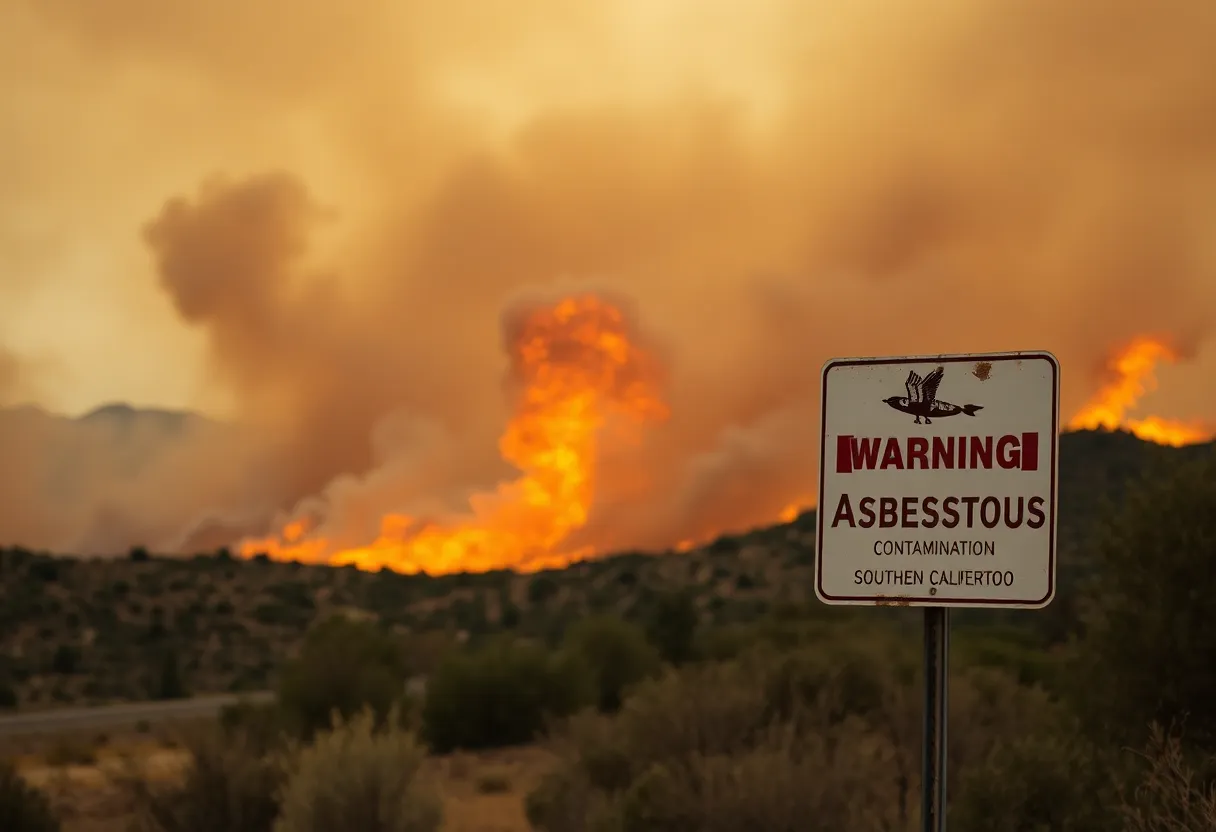News Summary
The wildfires in Southern California pose severe health risks due to released toxic asbestos from older buildings, endangering residents’ health.
Southern California Wildfires Release Toxic Asbestos, Bringing Health Risks
As the wildfires in southern California continue to rage uncontrollably, the aftermath reveals not only significant loss of life and property but also a hidden danger that could jeopardize the health of countless residents: toxic asbestos. Once confined within the walls of older buildings, asbestos has been unleashed into the environment due to the intense heat generated by the fires. This is not only a disaster but a symbolic wake-up call regarding the dangers of this naturally occurring mineral.
The Asbestos Threat
Asbestos fibers are notorious for being a leading cause of mesothelioma, a rare and deadly form of cancer. Sadly, this aggressive disease claims approximately 2,500 lives annually in the United States alone. The ongoing wildfires in Los Angeles and surrounding areas have heightened risks of asbestos exposure, especially in neighborhoods with older structures built before 1980, many of which inevitably harbor this dangerous material. The California Department of Forestry and Fire Protection has identified numerous buildings across the fire-affected areas as potential sources of legacy asbestos.
Cleanup Concerns and Safety Protocols
In the immediate aftermath of the wildfires, residents engaging in cleanup efforts are at risk of inadvertently exposing themselves to hazardous asbestos fibers. Clothing worn during these activities can carry invisible asbestos debris, presenting a serious danger when transported into homes. As such, it is imperative for individuals involved in cleanup to remove contaminated clothing promptly, seal it in a bag, and clean it before returning home. When in doubt, it may be safer to dispose of potentially contaminated garments altogether.
Potential for Long-Term Contamination
Even household items that survived the flames may be contaminated with asbestos, particularly those with porous surfaces or fabric. Reports indicate that items like sofas, blankets, and various appliances should generally be replaced to avoid prolonged exposure. The risk is exacerbated by the fear that asbestos fibers can remain lodged in walls, rooms, or vehicles, posing long-term risks and potentially exposing family and friends to its dangers.
The Urgent Need for Professional Intervention
Residents are urged to steer clear of cleanup sites until trained professionals have thoroughly cleared the debris and confirmed that air quality is safe. Because wildfires often stir airborne particles, which can include harmful asbestos, community members are recommended to seek temporary housing while awaiting safety verification. The introduction of hazy air quality filled with particulates, including asbestos, emphasizes the need for caution.
Protective Equipment is Essential
For those who must participate in cleanup efforts, protective gear is not just advisable; it is essential. Wearing N95 masks, gloves, long-sleeved shirts, and pants is crucial in minimizing exposure to asbestos. The fibers can cling to skin or hair, making protective clothing imperative to avoid contamination when returning home. Airborne asbestos remains a concern, as wind can carry these hazardous particles across vast distances.
The Broader Context: Increasing Wildfire Incidence
Climate change has fueled an increase in the frequency and intensity of wildfires. This, coupled with the existing legacy of asbestos mines, poses ongoing risks, raising alarms across health advocacy groups advocating for greater awareness and even a nationwide asbestos ban. Such incidents only highlight the critical need for preventive measures in contexts where wildfires ravage neighborhoods containing hazardous materials.
Conclusion: An Ongoing Crisis
The current situation in southern California serves as a dire reminder of how fire events create complex health risks that may take a long time to fully manifest. While restoring the lost sense of normalcy is a priority, safety must take precedence over the sentimental urge to salvage belongings. Without a doubt, the invisible threat of asbestos contamination proves that in the wake of wildfires, vigilance and caution are paramount.
Deeper Dive: News & Info About This Topic
HERE Resources
USS Haynsworth: A Ship’s Illustrious History and Grim Legacy
Historic Ban on Asbestos Use Announced by EPA
Fairmont State University Faces Asbestos Lawsuit Amid Health Concerns
Historic Asbestos Ban: A Turning Point in Public Health
California Wildfires Ignite Hazardous Cleanup Challenges
Wildfires Ravage Los Angeles: The Hidden Danger of Asbestos Exposure
Retired Radio Engineer’s Asbestos Death Highlights Risks
Inquest Launched Following the Death of Former Factory Worker Linked to Asbestos Exposure
Great-Grandfather from Swindon Dies from Asbestos-Related Disease
EE Kilburn Store Closure Due to Asbestos Discovery
Additional Resources
- Asbestos.com: Raging California Wildfires May Spread Toxic Asbestos
- Wikipedia: Asbestos
- CityWatch LA: 4 Tips for Avoiding Asbestos Exposure from California Wildfires
- Google Search: Safety Asbestos Exposure Wildfires
- Mesothelioma Guide: California Wildfires and Asbestos Exposure
- Encyclopedia Britannica: Asbestos
- Asbestos.com: Asbestos Warnings Issued California Wildfires
- Google News: California Wildfires Asbestos



















